Adsorption Properties and Mechanism of Copper Ions from Wastewater by Lessonia nigrescens and Lessonia nigrescens Residue
Abstract
:1. Introduction
2. Materials and Methods
2.1. Raw Materials and Chemicals
2.2. Residue Seaweed Preparation
2.3. Characterization of Original Seaweed Particles and the Seaweed Particles after Cu2+ Adsorption
2.4. Cu2+ Removal by L. nigrescens Particles and Seaweed Residue
2.5. Adsorption Isotherms
2.6. Adsorption Kinetics
2.7. Adsorption Thermodynamics
3. Result and Discussion
3.1. Characterization of the Seaweed Particles
3.2. Cu2+ Adsorption by the L. nigrescens Particles and Seaweed Residues
3.2.1. Effect of Different Contact Time
3.2.2. Effect of Seaweed Loading
3.2.3. Effect of Initial Cu2+ Concentration
3.2.4. Effect of Temperature
3.2.5. Effect of pH
3.2.6. Regeneration of the Adsorbents and Cu2+ Re-Adsorption
3.3. Kinetic Modeling
4. Conclusions
Author Contributions
Funding
Data Availability Statement
Acknowledgments
Conflicts of Interest
References
- Azimi, A.; Azari, A.; Rezakazemi, M.; Ansarpour, M. Removal of heavy metals from industrial wastewaters: A Review. ChemBioEng Rev. 2017, 4, 37–59. [Google Scholar] [CrossRef]
- Nadeem, R.; Zafar, M.N.; Afzal, A.; Hanif, M.A.; Saeed, R. Potential of NaOH pretreated Mangifera indica waste biomass for the mitigation of Ni (II) and Co (II) from aqueous solutions. J. Taiwan Inst. Chem. Eng. 2014, 45, 967–972. [Google Scholar] [CrossRef]
- Zhuang, Q.F.; Li, G.; Liu, Z.Y. Distribution, source and pollution level of heavy metals in river sediments from South China. Catena Interdiscip. J. Soil Sci. Hydrol. Geomorphol. Focus. Geoecology Landsc. Evol. 2018, 170, 386–389. [Google Scholar] [CrossRef]
- Wei, C.Y.; Wang, C.; Yang, L.S. Characterizing spatial distribution and sources of heavy metals in the soils from mining-smelting activities in Shuikoushan, Hunan Province, China. J. Environ. Sci. 2009, 21, 1230–1236. [Google Scholar] [CrossRef] [PubMed]
- Karri, V.; Schuhmacher, M.; Kumar, V. Heavy metals (Pb, Cd, As and MeHg) as risk factors for cognitive dysfunction: A general review of metal mixture mechanism in brain. Environ. Toxicol. Pharmacol. 2016, 48, 203–213. [Google Scholar] [CrossRef] [PubMed]
- Zhang, Y.; Shang, P.; Wang, J.; Norris, P.; Romero, C.E.; Pan, W.P. Trace element (Hg, As, Cr, Cd, Pb) distribution and speciation in coal-fired power plants. Fuel 2017, 208, 647–654. [Google Scholar] [CrossRef]
- Johri, N.; Jacquillet, G.; Unwin, R. Heavy metal poisoning: The effects of cadmium on the kidney. Biometals 2010, 23, 783–792. [Google Scholar] [CrossRef]
- Zhang, W.; Pu, Q.; Mei, J.; Lin, F.; Zeng, Y.; Wang, W.; Li, W.; Liu, C.; Zhu, Y. Combined minimally invasive treatment of delayed aortoesophageal fistula caused by fishbone. Ann. Thorac. Surg. 2022, 114, e415–e418. [Google Scholar] [CrossRef]
- Sun, J.H.; Chen, Y.; Yu, H.; Yan, L.; Du, B.; Pei, Z. Removal of Cu2+, Cd2+ and Pb2+ from aqueous solutions by magnetic alginate microsphere based on Fe3O4/MgAl-layered double hydroxide. J. Colloid Interface Sci. 2018, 532, 474–484. [Google Scholar] [CrossRef] [PubMed]
- De Rossi, A.; Rigueto, C.V.T.; Dettmer, A.; Colla, L.M.; Piccin, J.S. Synthesis, characterization, and application of Saccharomyces cerevisiae/alginate composites beads for adsorption of heavy metals. J. Environ. Chem. Eng. 2020, 8, 104009. [Google Scholar] [CrossRef]
- Deze, E.G.; Papageorgiou, S.K.; Favvas, E.P.; Katsaros, F.K. Porous alginate aerogel beads for effective and rapid heavy metal sorption from aqueous solutions: Effect of porosity in Cu2+ and Cd2+ ion sorption. Chem. Eng. J. 2012, 209, 537–546. [Google Scholar] [CrossRef]
- Jiang, H.; Yang, Y.; Lin, Z.; Zhao, B.; Zhang, A. Preparation of a novel bio-adsorbent of sodium alginate grafted polyacrylamide/graphene oxide hydrogel for the adsorption of heavy metal ion. Sci. Total Environ. 2020, 744, 140653. [Google Scholar] [CrossRef]
- Alyuez, B.; Veli, S. Kinetics and equilibrium studies for the removal of nickel and zinc from aqueous solutions by ion exchange resins. J. Hazard. Mater. 2009, 167, 482–488. [Google Scholar] [CrossRef] [PubMed]
- Haris, M.; Shakeel, A.; Hussain, T.; Ahmad, G.; Ansari, M.S.; Khan, A.A. New Trends in Removing Heavy Metals from Industrial Wastewater Through Microbes. Remov. Emerg. Contam. Through Microb. Process. 2021, 183–205. [Google Scholar] [CrossRef]
- Chen, Q.; Yao, Y.; Li, X.; Lu, J.; Zhou, J.; Huang, Z. Comparison of heavy metal removals from aqueous solutions by chemical precipitation and characteristics of precipitates. J. Water Process. Eng. 2018, 26, 289–300. [Google Scholar] [CrossRef]
- Chaplin, B.P. The Prospect of Electrochemical Technologies Advancing Worldwide Water Treatment. Acc. Chem. Res. 2019, 52, 596–604. [Google Scholar] [CrossRef] [PubMed]
- Zhu, Y.; Fan, W.; Zhou, T.; Li, X. Removal of chelated heavy metals from aqueous solution: A review of current methods and mechanisms. Sci. Total Environ. 2019, 678, 253–266. [Google Scholar] [CrossRef]
- Fu, F.; Wang, Q. Removal of heavy metal ions from wastewaters: A review. J. Environ. Manag. 2011, 92, 407–418. [Google Scholar] [CrossRef] [PubMed]
- Burakov, A.E.; Galunin, E.V.; Burakova, I.V.; Kucherova, A.E.; Agarwal, S.; Tkachev, A.G.; Gupta, V.K. Adsorption of heavy metals on conventional and nanostructured materials for wastewater treatment purposes: A review. Ecotoxicol. Environ. Saf. 2018, 148, 702–712. [Google Scholar] [CrossRef]
- Zafar, M.N.; Parveen, A.; Nadeem, R. A pretreated green biosorbent based on Neem leaves biomass for the removal of lead from wastewater. Desalination Water Treat. 2013, 51, 4459–4466. [Google Scholar] [CrossRef]
- Fiyadh, S.S.; Alsaadi, M.A.; Jaafar, W.Z.; Alomar, M.K.; Fayaed, S.S.; Mohd, N.S.; Hin, L.S.; El-Shafie, A. Review on heavy metal adsorption processes by carbon nanotubes. J. Clean. Prod. 2019, 230, 783–793. [Google Scholar] [CrossRef]
- Navarrete, I.A.; Kim, D.Y.; Wilcox, C.; Reed, D.C.; Wilcox, B.H. Effects of depth-cycling on nutrient uptake and biomass production in the giant kelp Macrocystis pyrifera. Renew. Sustain. Energy Rev. 2021, 141, 110747. [Google Scholar] [CrossRef]
- Hansen, H.K.; Gutierrez, C.; Madrid, A.; Jimenez, R.; Larach, H. Possible use of the algae Lessonia nigrescens as a biosorbent: Differences in copper sorption behavior using either blades or stipes. Waste Biomass Valorization 2017, 8, 1295–1302. [Google Scholar] [CrossRef]
- Kabir, I.I.; Sorrell, C.C.; Mofarah, S.S.; Yang, W.; Yuen, A.C.Y.; Nazir, M.T.; Yeoh, G.H. Alginate/polymer-based materials for fire retardancy: Synthesis, structure, properties, and applications. Polym. Rev. 2021, 61, 357–414. [Google Scholar] [CrossRef]
- Cebrián-Lloret, V.; Metz, M.; Martínez-Abad, A.; Knutsen, S.H.; Ballance, S.; López-Rubio, A.; Martínez-Sanz, M. Valorization of alginate-extracted seaweed biomass for the development of cellulose-based packaging films. Algal Res. 2022, 61, 102576. [Google Scholar] [CrossRef]
- Foo, K.Y.; Hameed, B.H. Insights into the modeling of adsorption isotherm systems. Chem. Eng. J. 2010, 156, 2–10. [Google Scholar] [CrossRef]
- Cid, H.A.; Flores, M.I.; Pizarro, J.F.; Castillo, X.A.; Barros, D.E.; Moreno-Piraján, J.C.; Ortiz, C.A. Mechanisms of Cu2+ biosorption on Lessonia nigrescens dead biomass: Functional groups interactions and morphological characterization. J. Environ. Chem. Eng. 2018, 6, 2696–2704. [Google Scholar] [CrossRef]
- Davis, T.A.; Llanes, F.; Volesky, B.; Diaz-Pulido, G.; McCook, L.; Mucci, A. 1H-NMR study of Na alginates extracted from Sargassum spp. in relation to metal biosorption. Appl. Biochem. Biotechnol. 2003, 110, 75–90. [Google Scholar] [CrossRef]
- Carvalho, R.P.D.; Chong, K.H.; Volesky, B. Effects of leached alginate on metal biosorption. Biotechnol. Lett. 1994, 16, 875–880. [Google Scholar] [CrossRef]
- Fernando, I.S.; Sanjeewa, K.A.; Kim, S.Y.; Lee, J.S.; Jeon, Y.J. Reduction of heavy metal (Pb2+) biosorption in zebrafish model using alginic acid purified from Ecklonia cava and two of its synthetic derivatives. Int. J. Biol. Macromol. 2018, 106, 330–337. [Google Scholar] [CrossRef]
- Zhang, R.; Richardson, J.J.; Masters, A.F.; Yun, G.; Liang, K.; Maschmeyer, T. Effective Removal of Toxic Heavy Metal Ions from Aqueous Solution by CaCO3 Microparticles. Water Air Soil Pollut. 2018, 229, 136. [Google Scholar] [CrossRef]
- Huo, F.; Liu, Y.; Tang, Y.; Cao, Y.; Tan, C.; Yang, F.; Yang, X. Aggregation induced emission of amino-thiol capped gold nanoparticles (GNPs) through metal-amino-coordination. Colloids Surf. B Biointerfaces 2019, 183, 110335. [Google Scholar] [CrossRef]
- Li, R.; Zhang, T.; Zhong, H.; Song, W.; Yin, X. Bioadsorbents from algae residues for heavy metal ions adsorption: Chemical modification, adsorption behavior and mechanism. Environ. Technol. 2020, 1–44. [Google Scholar] [CrossRef] [PubMed]
- Nzayisenga, J.C.; Niemi, C.; Ferro, L.; Gorzsas, A.; Gentili, F.G.; Funk, C.; Sellstedt, A. Screening Suitability of Northern Hemisphere Algal Strains for Heterotrophic Cultivation and Fatty Acid Methyl Ester Production. Molecules 2020, 25, 2107. [Google Scholar] [CrossRef]
- Abomohra, E.F.; El-Hefnawy, M.E.; Wang, Q.; Huang, J.; Li, L.; Tang, J.; Mohammed, S. Sequential bioethanol and biogas production coupled with heavy metal removal using dry seaweeds: Towards enhanced economic feasibility. J. Clean. Prod. 2021, 316, 128341. [Google Scholar] [CrossRef]
- Vieira, A.P.; Santana, S.A.; Bezerra, C.W.; Silva, H.A.; de Melo, J.C.; da Silva Filho, E.C.; Airoldi, C. Copper sorption from aqueous solutions and sugar cane spirits by chemically modified babassu coconut (Orbignya speciosa) mesocarp. Chem. Eng. J. Lausanne 2010, 161, 99–105. [Google Scholar] [CrossRef]
- Papageorgiou, S.K.; Kouvelos, E.P.; Favvas, E.P.; Sapalidis, A.A.; Romanos, G.E.; Katsaros, F.K. Metal-carboxylate interactions in metal-alginate complexes studied with FTIR spectroscopy. Carbohydr. Res. 2010, 345, 469–473. [Google Scholar] [CrossRef]
- Mao, S.C.; Yu, X.Y.; Shen, Y.; Zheng, K.C. Ab initio study on the H–Bonding complexes formed from phenol and a series of amides. Chin. J. Org. Chem. 2000, 20, 243–247. [Google Scholar]
- Pereira, L.; Gheda, S.F.; Ribeiro-Claro, P.J.A. Analysis by vibrational spectroscopy of seaweed polysaccharides with potential use in food, pharmaceutical, and cosmetic industries. Int. J. Carbohydr. Chem. 2013, 2013, 7. [Google Scholar] [CrossRef]
- Leal, D.; Matsuhiro, B.; Rossi, M.; Caruso, F. FT-IR spectra of alginic acid block fractions in three species of brown seaweeds. Carbohydr. Res. 2008, 343, 308–316. [Google Scholar] [CrossRef] [PubMed]
- Filote, C.; Volf, I.; Santos, S.C.R.; Botelho, C.M.S. Bioadsorptive removal of Pb (II) from aqueous solution by the biorefinery waste of Fucus spiralis. Sci. Total Environ. 2018, 648, 1201–1209. [Google Scholar] [CrossRef] [PubMed]
- Moirana, R.L.; Mkunda, J.; Machunda, R.; Paradelo, M.; Mtei, K. Hydroxyapatite-activated seaweed biochar for enhanced remediation of fluoride contaminated soil at various pH ranges. Environ. Adv. 2023, 11, 100329. [Google Scholar] [CrossRef]
- Jia, C.G.; Zhang, Y.P.; Wang, H.; Ou, G.N.; Lin, J.M. Rapid biosorption and reduction removal of Cr (VI) from aqueous solution by dried seaweeds. J. Cent. South Univ. Technol. 2014, 21, 2801–2809. [Google Scholar] [CrossRef]
- Murphy, V.; Hughes, H.; Mcloughlin, P. Comparative study of chromium biosorption by red, green and brown seaweed biomass. Chemosphere 2008, 70, 1128–1134. [Google Scholar] [CrossRef] [PubMed]
- Gubała, D.; Taylor, N.; Harniman, R.; Rawle, J.; Hussain, H.; Robles, E.; Chen, M.; Briscoe, W.H. Structure, Nanomechanical properties, and wettability of organized erucamide layers on a polypropylene surface. Langmuir 2021, 37, 6521–6532. [Google Scholar] [CrossRef]
- Hamdaoui, O. General analytical solution expressions for analyzing Langmuir-type kinetics of sonochemical degradation of nonvolatile organic contaminants in water. Ultrason. Sonochemistry 2023, 98, 106536. [Google Scholar] [CrossRef] [PubMed]
- Kokalj, A. On the use of the Langmuir and other adsorption isotherms in corrosion inhibition. Corros. Sci. 2023, 217, 111112. [Google Scholar] [CrossRef]
- Belhaj, A.F.; Elraies, K.A.; Mahmood, S.M.; Zulkifli, N.N.; Akbari, S.; Hussien, O.S. The effect of surfactant concentration, salinity, temperature, and pH on surfactant adsorption for chemical enhanced oil recovery: A review. J. Pet. Explor. Prod. Technol. 2019, 10, 125–137. [Google Scholar] [CrossRef]
- Huangfu, C.; Yu, S.; Tong, B.; Yang, A.; Lyu, J.; Guo, X. Efficient lithium extraction from aqueous solutions by MIL-100(Fe): A study on adsorption kinetics, thermodynamics and mechanism. Sep. Purif. Technol. 2023, 322, 124365. [Google Scholar] [CrossRef]
- Ngobeni, W.A.; Mulaba-Bafubiandi, A.F. Investigating the thermodynamics and adsorption mechanisms of alkaline gelatinised novel depressants on pyrite surface. J. Mol. Liq. 2023, 384, 122173. [Google Scholar] [CrossRef]
- Genç-Fuhrman, H.; Mikkelsen, P.S.; Ledin, A. Simultaneous removal of As, Cd, Cr, Cu, Ni and Zn from stormwater using high-efficiency industrial sorbents: Effect of pH, contact time and humic acid. Sci. Total Environ. 2016, 566–567, 76–85. [Google Scholar] [CrossRef] [PubMed]
- Sajib, M.; Forghani, B.; Vate, N.K.; Abdollahi, M. Combined effects of isolation temperature and pH on functionality and beany flavor of pea protein isolates for meat analogue applications. Food Chem. 2023, 412, 135585. [Google Scholar] [CrossRef]
- Panigrahi, A.; Behera, R.K.; Mishra, L.; Kumar, S.; Dubey, P.; Dutta, S.; Sarangi, M.K. Exploring optoelectronic properties of undoped and amine-doped carbon dots: Impact of surface functionalization and pH. Carbon 2023, 206, 114–123. [Google Scholar] [CrossRef]
- Barquilha, C.E.R.; Cossich, E.S.; Tavares, C.R.G.; Silva, E.A. Biosorption of nickel (II) and copper (II) ions by Sargassum sp. in nature and alginate extraction products. Bioresour. Technol. Rep. 2019, 5, 43–50. [Google Scholar] [CrossRef]
- Zhang, R.; Richardson, J.J.; Masters, A.F.; Maschmeyer, T. Removal of Pb2+ from water using sustainable brown seaweed phlorotannins. Langmuir 2022, 38, 8324–8333. [Google Scholar] [CrossRef]
- Fuks, L.; Filipiuk, D.; Majdan, M. Transition metal complexes with alginate biosorbent. J. Mol. Struct. 2006, 792–793, 104–109. [Google Scholar] [CrossRef]
- Tasić, T.; Milanković, V.; Batalović, K.; Breitenbach, S.; Unterweger, C.; Fürst, C.; Pašti, I.; Lazarević-Pašti, T. Application of viscose-based porous carbon fibers in food processing—Malathion and chlorpyrifos removal. Foods 2023, 12, 2362. [Google Scholar] [CrossRef]
- Milanković, V.; Tasić, T.; Pejčić, M.; Pašti, I.; Lazarević-Pašti, T. Spent coffee grounds as an adsorbent for malathion and chlorpyrifos—Kinetics, thermodynamics, and eco-Neurotoxicity. Foods 2023, 12, 2397. [Google Scholar] [CrossRef]
- Bonetto, L.R.; Ferrarini, F.; De Marco, C.; Crespo, J.S.; Guégan, R.; Giovanela, M. Removal of methyl violet 2B dye from aqueous solution using a magnetic composite as an adsorbent. J. Water Process. Eng. 2015, 6, 11–20. [Google Scholar] [CrossRef]
- Debnath, S.; Das, R. Strong adsorption of CV dye by Ni ferrite nanoparticles for waste water purification: Fits well the pseudo second order kinetic and Freundlich isotherm model. Ceram. Int. 2023, 49, 16199–16215. [Google Scholar] [CrossRef]
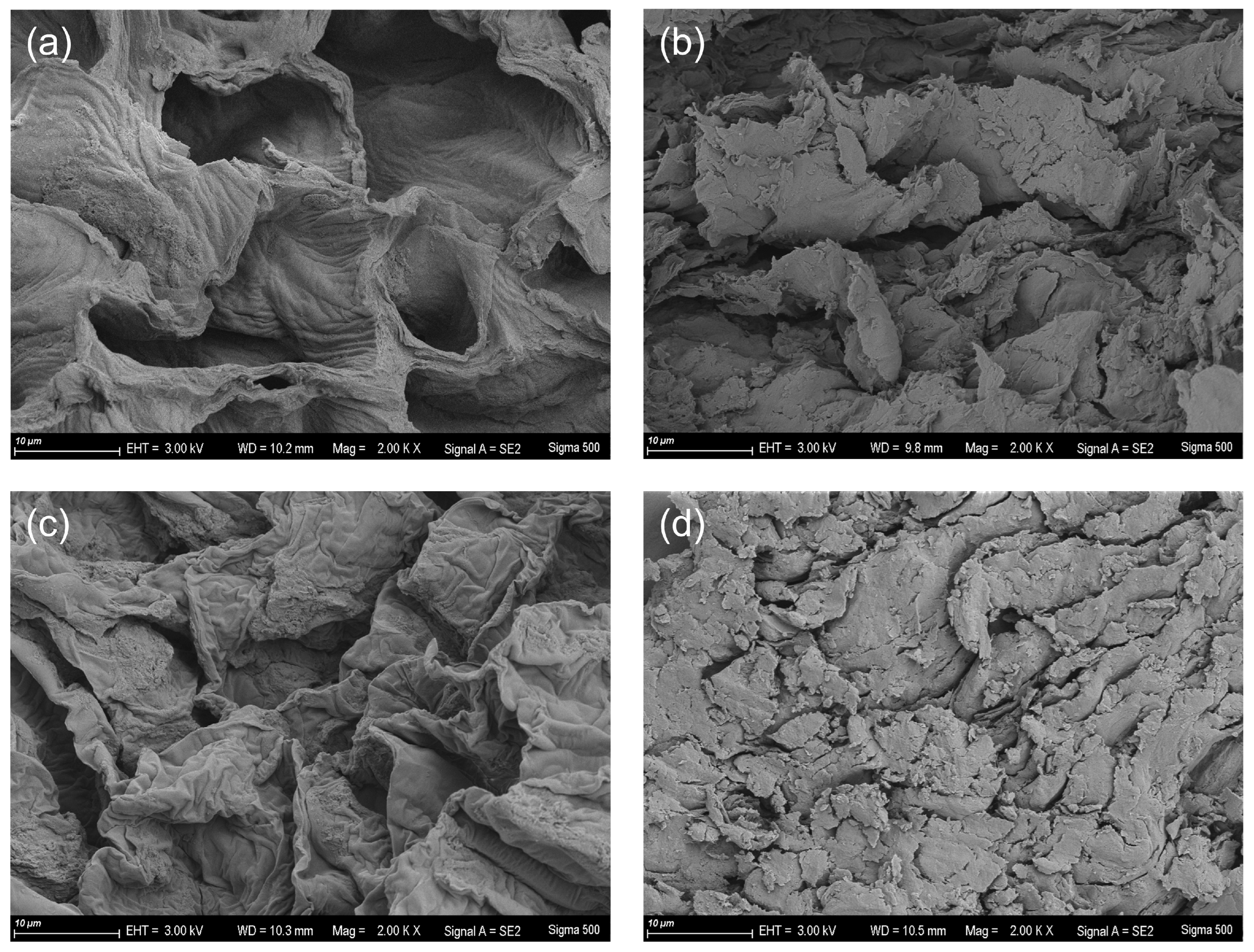

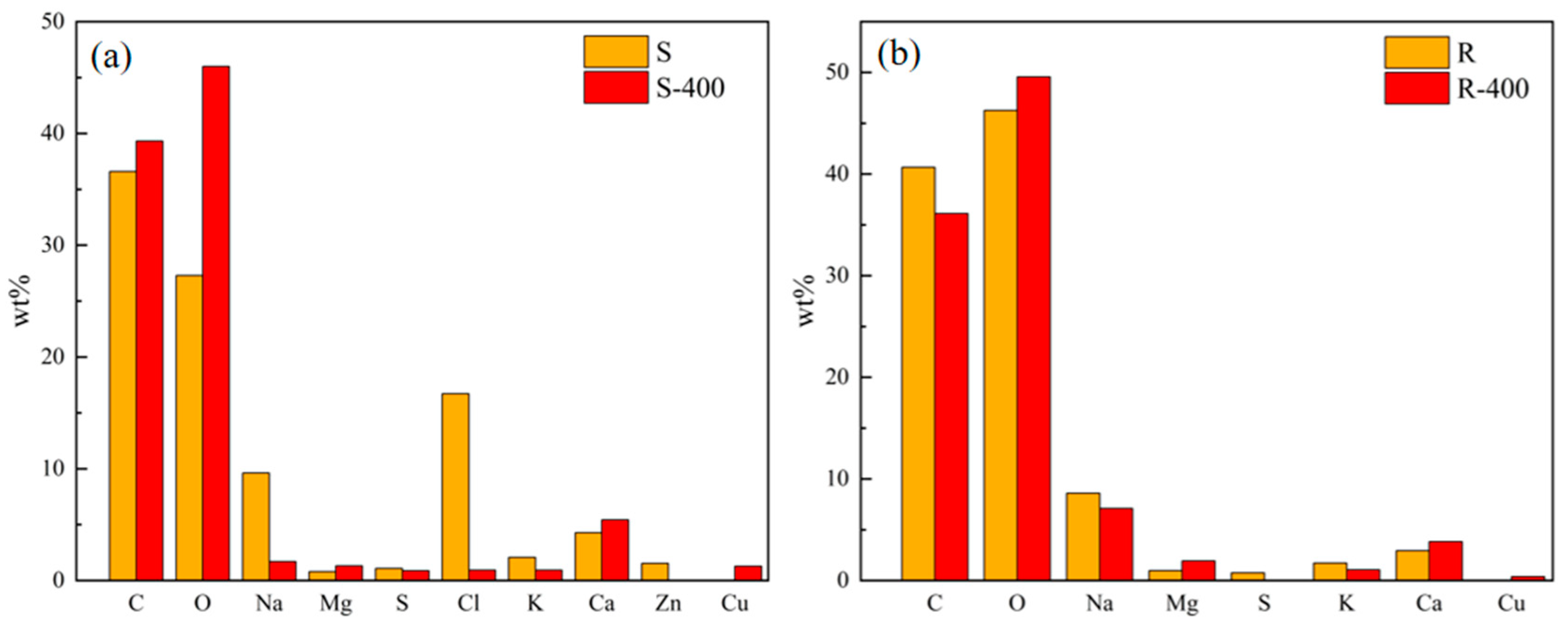
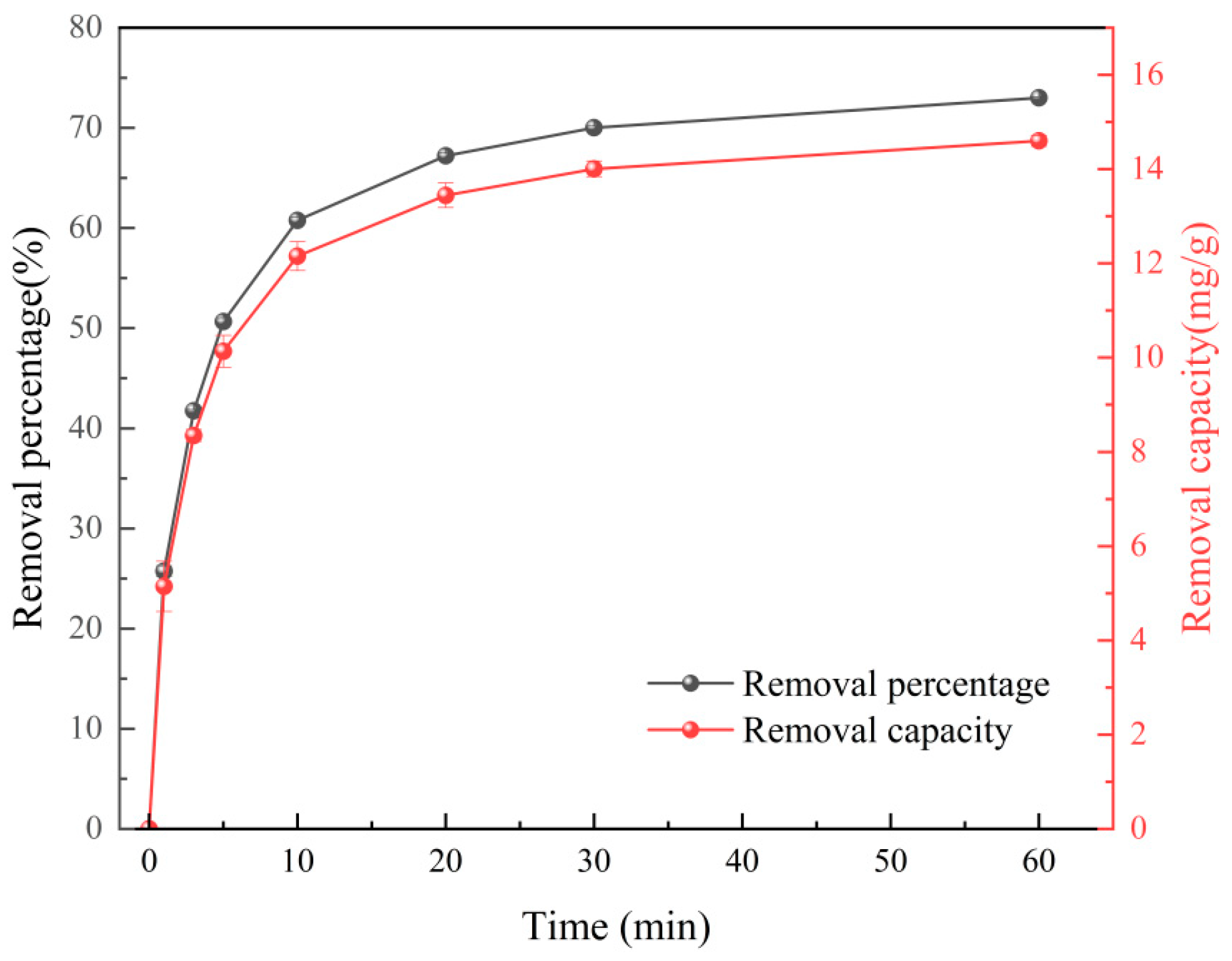
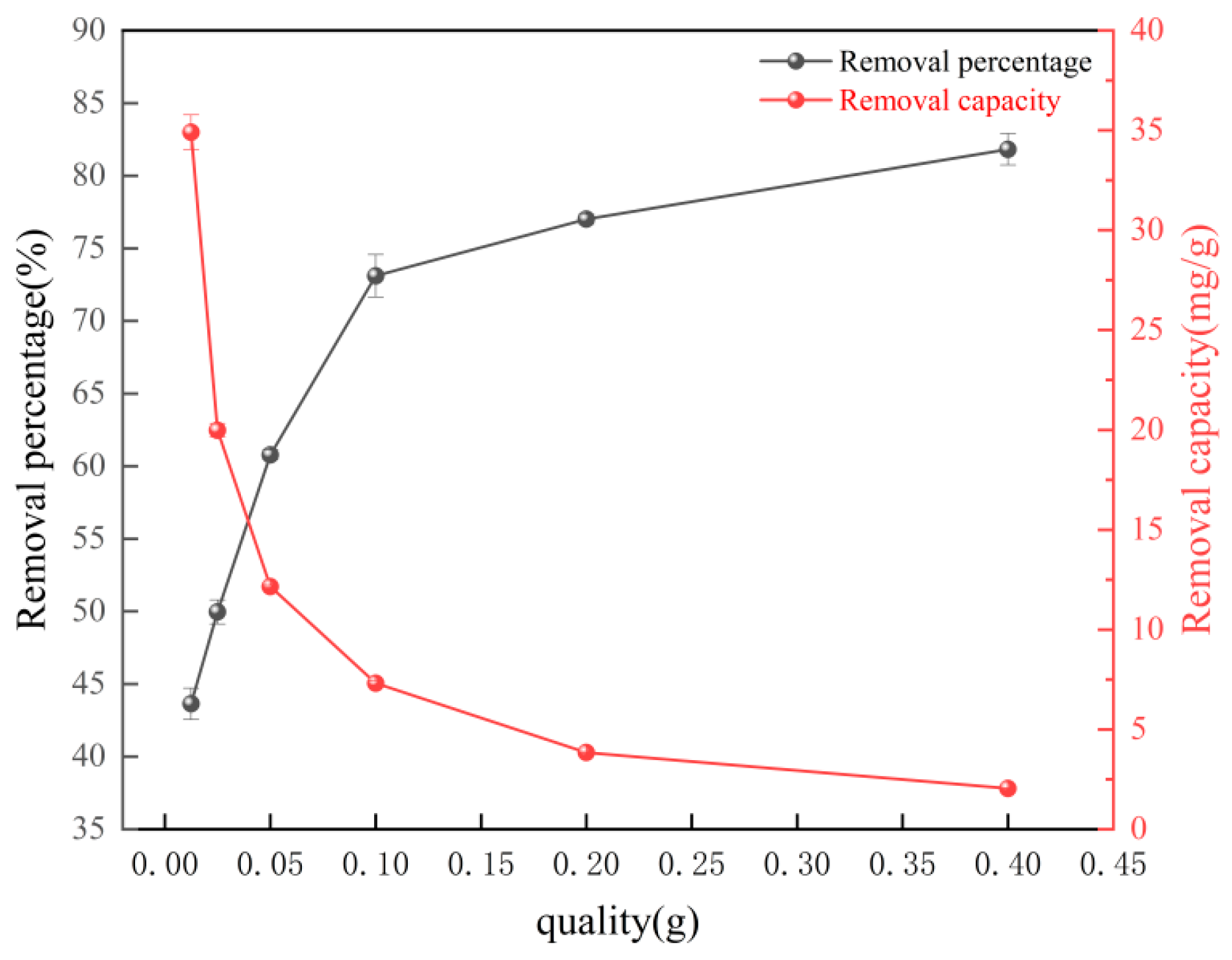
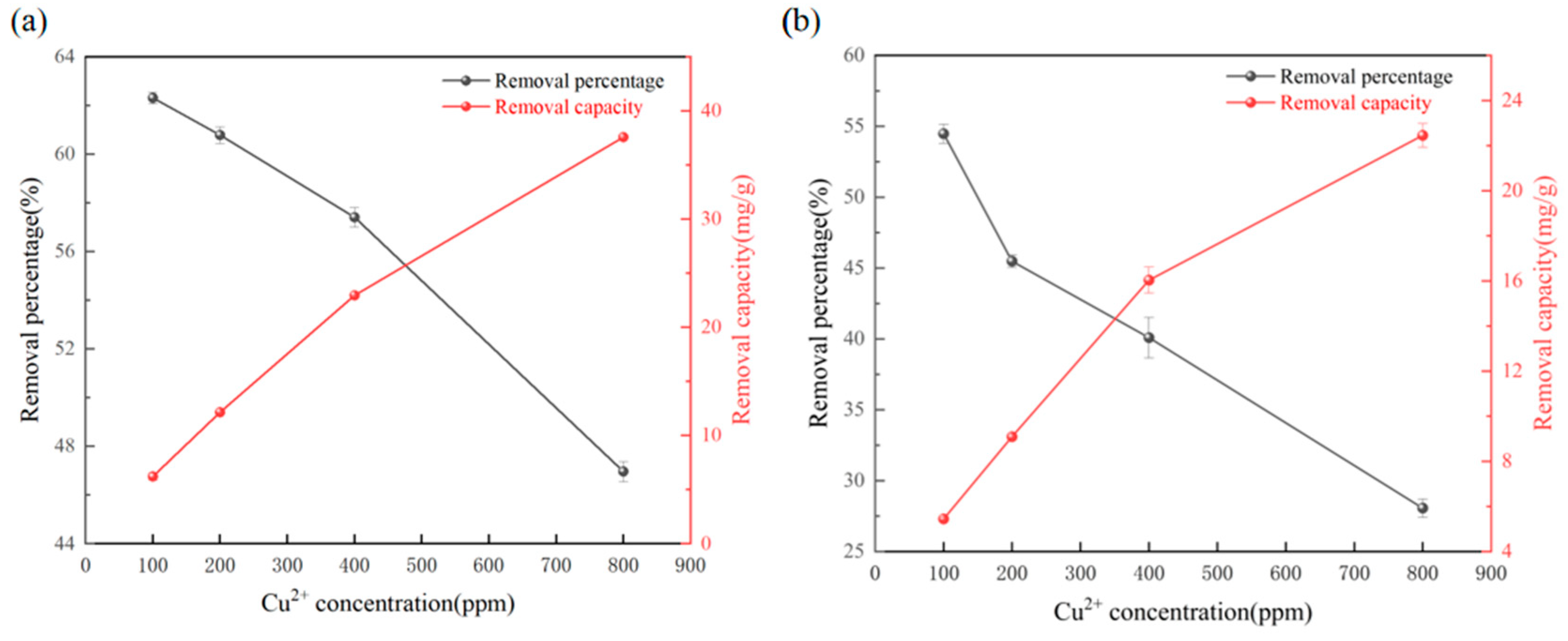
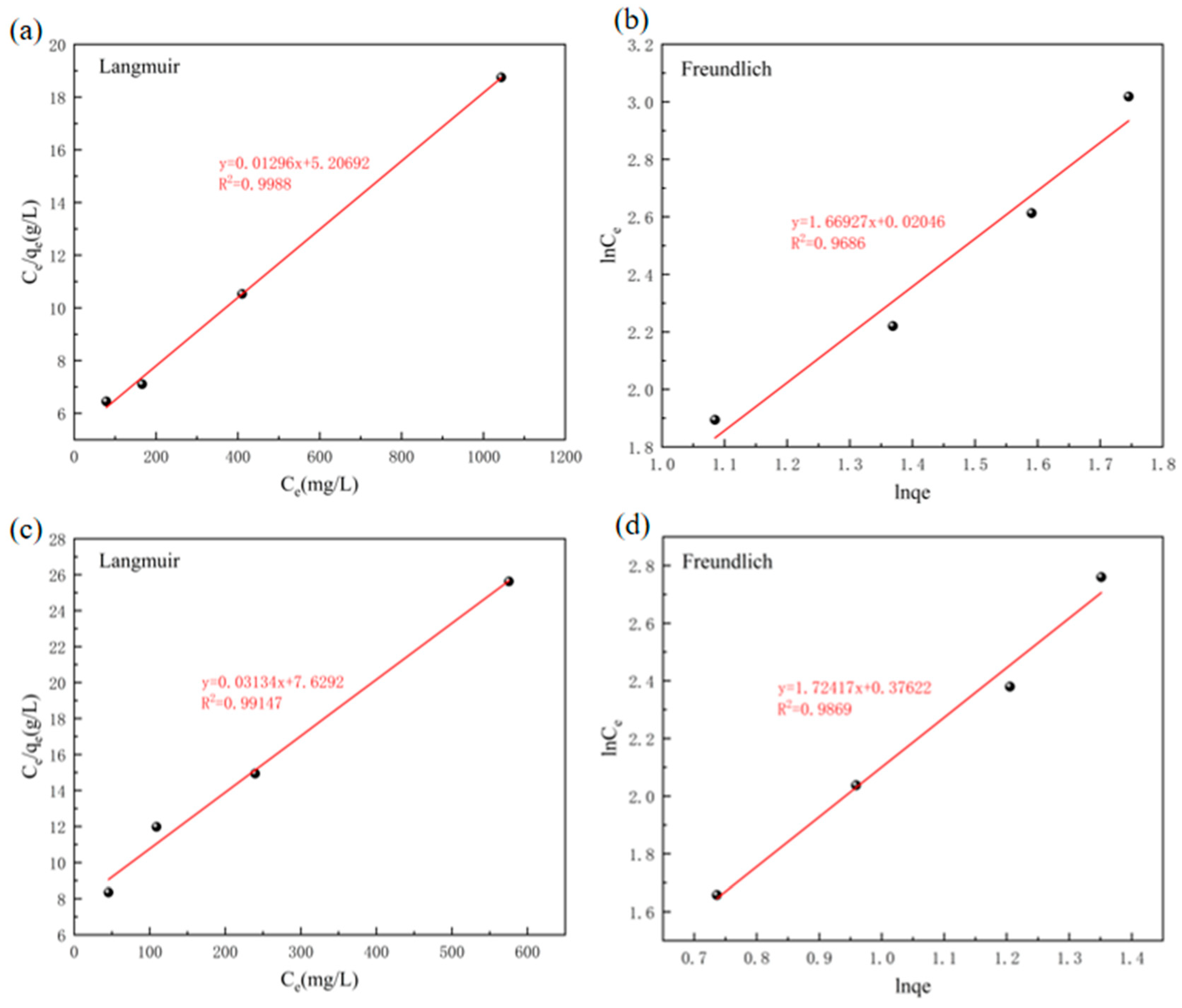
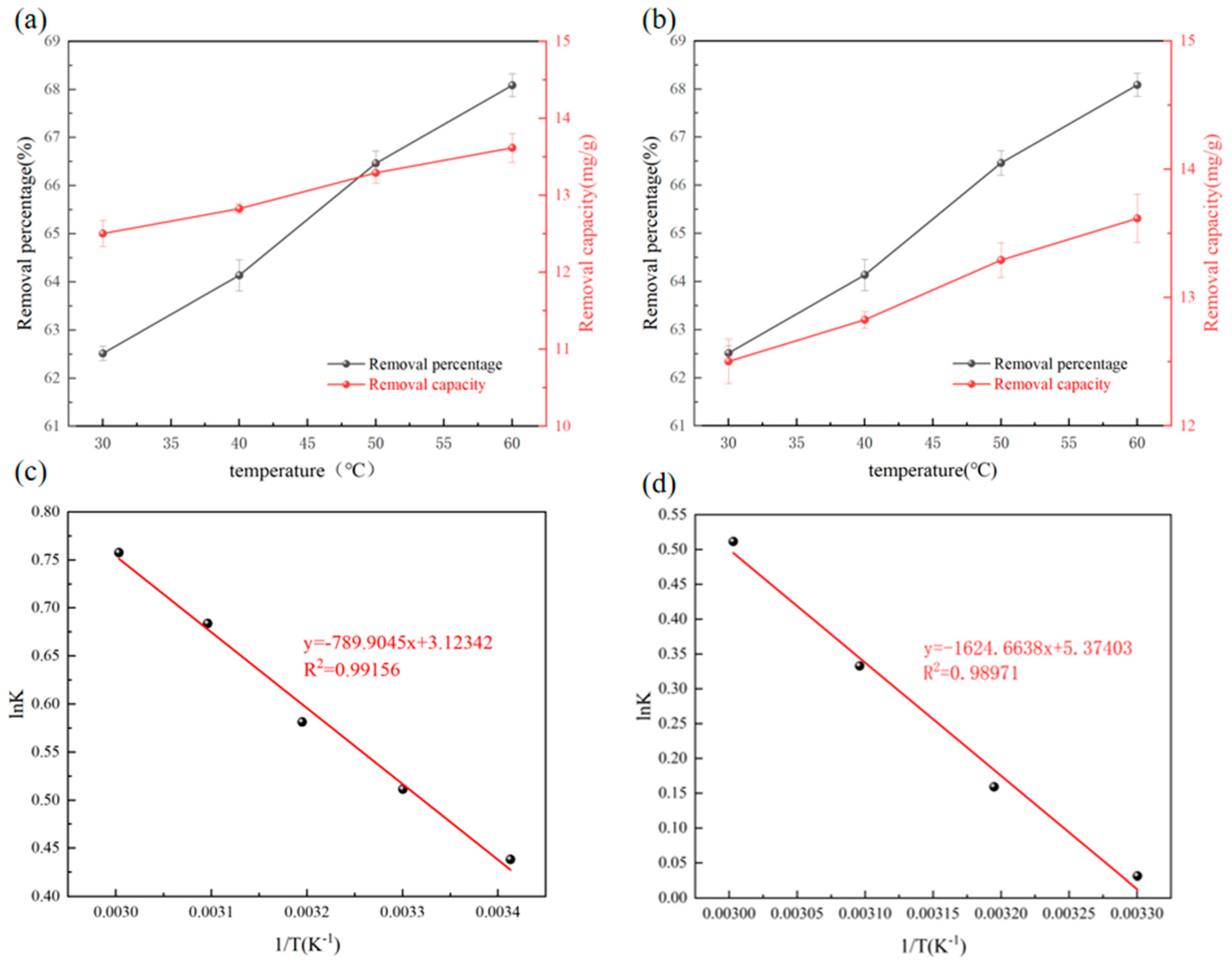


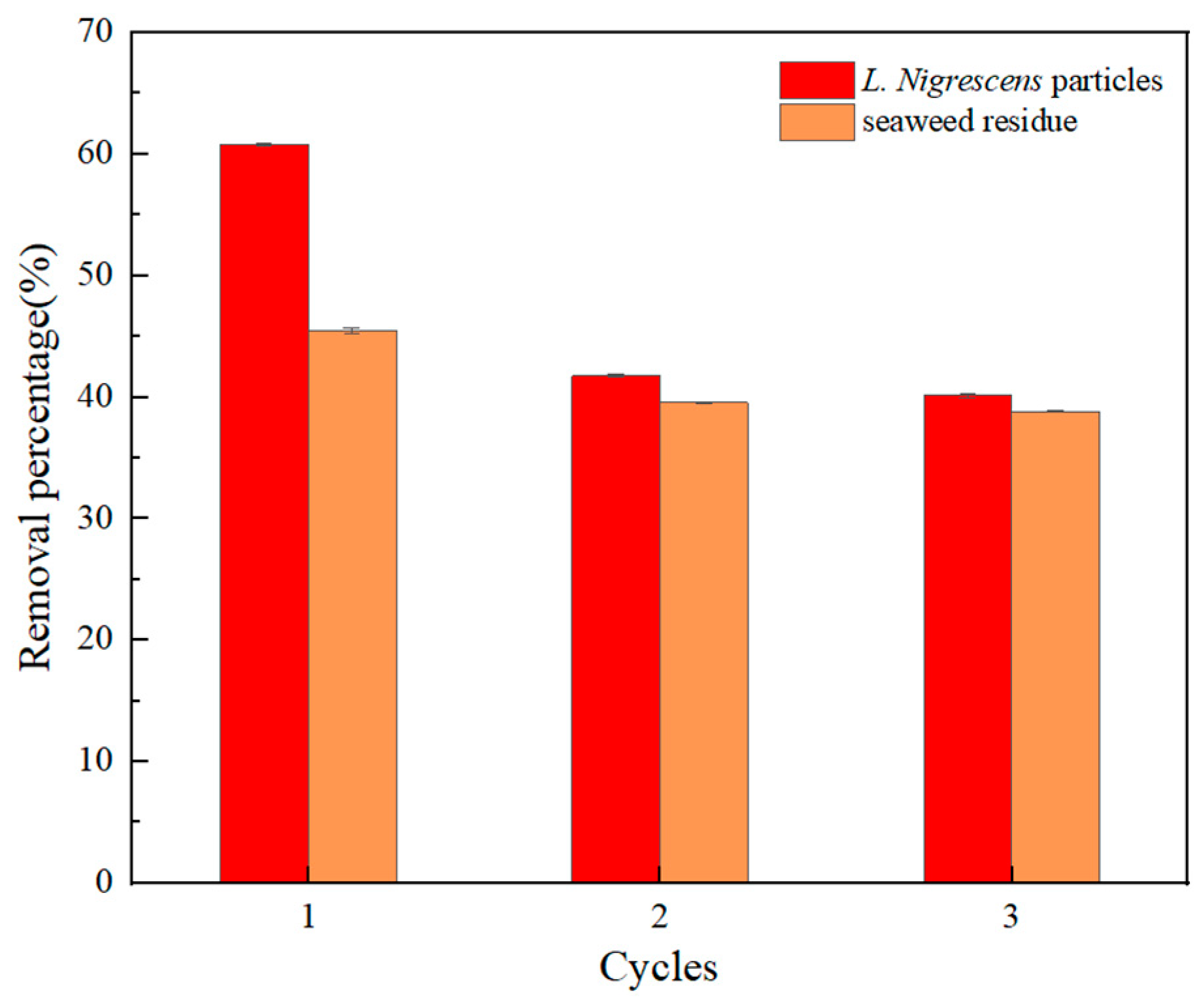
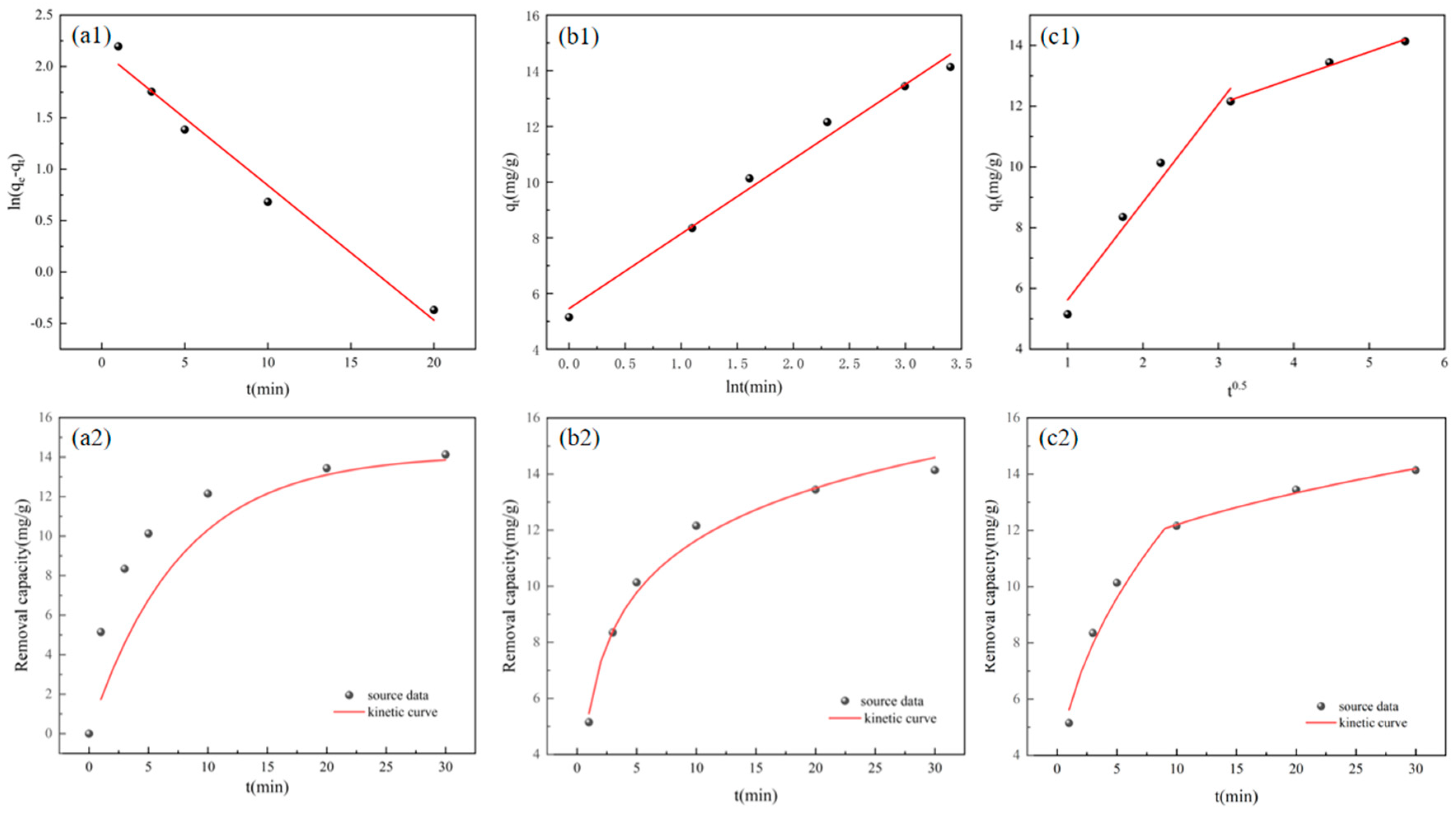
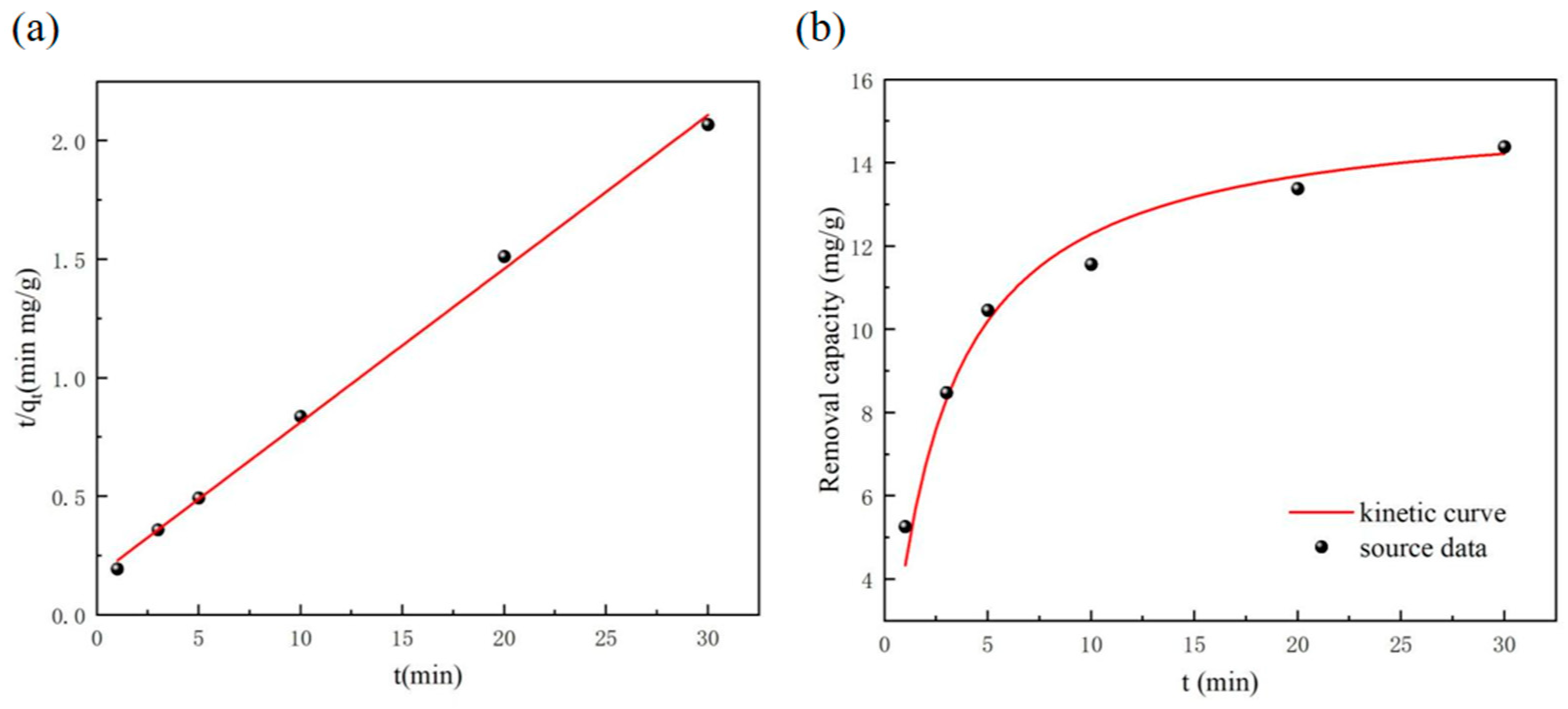
| Adsorbent | Model | Parameter | Value | R2 |
|---|---|---|---|---|
| L. nigrescens particles | Langmuir | KL (L mg−1) | 0.0025 | 0.9988 |
| qmax (mg g−1) | 77.165 | |||
| Freundlich | KF (mg g−1) (L mg−1)1/nF) | 0.9878 | 0.9686 | |
| N (-) | 1.6693 | |||
| Seaweed residue | Langmuir | KL (L mg−1) | 0.0041 | 0.99147 |
| qmax (mg g−1) | 31.908 | |||
| Freundlich | KF (mg g−1) (L mg−1)1/nF) | 0.8039 | 0.9869 | |
| N (-) | 1.7242 |
| L. nigrescens Particles | Seaweed Residue | |||||
|---|---|---|---|---|---|---|
| T (K) | ΔG0 (kJ·mol−1) | ΔH0 (kJ·mol−1) | ΔS0 (J·mol−1·K−1) | ΔG0 (kJ·mol−1) | ΔH0 (kJ·mol−1) | ΔS0 (J·mol−1·K−1) |
| 303 | −1.2886 | 6.5673 | 25.9681 | −0.0787 | 13.5019 | 44.6797 |
| 313 | −1.5129 | −0.4143 | ||||
| 323 | −1.8369 | −0.8937 | ||||
| 333 | −2.0978 | −1.4161 | ||||
| Model | Model | ||
|---|---|---|---|
| Pseudo-first-order | Elovich | ||
| k1 (min−1) | 0.131 | α (mg/g min) | 20.5102 |
| R2 | 0.981 | β (g/mg) | 0.3725 |
| R2 | 0.988 | ||
| Pseudo-second-order | Intraparticle diffusion | ||
| qe (mg/g) | 15.129 | kd1 (mg/g min0.5) | 3.221 |
| k2 (g/mg min) | 0.028 | R2 | 0.984 |
| R2 | 0.997 | kd2 (mg/g min0.5) | 0.861 |
| R2 | 0.991 | ||
Disclaimer/Publisher’s Note: The statements, opinions and data contained in all publications are solely those of the individual author(s) and contributor(s) and not of MDPI and/or the editor(s). MDPI and/or the editor(s) disclaim responsibility for any injury to people or property resulting from any ideas, methods, instructions or products referred to in the content. |
© 2023 by the authors. Licensee MDPI, Basel, Switzerland. This article is an open access article distributed under the terms and conditions of the Creative Commons Attribution (CC BY) license (https://creativecommons.org/licenses/by/4.0/).
Share and Cite
Chen, H.; Zhang, R.; Qu, X.; Yuan, Y.; Zhu, B.; Zhao, S.; Jiang, T. Adsorption Properties and Mechanism of Copper Ions from Wastewater by Lessonia nigrescens and Lessonia nigrescens Residue. Separations 2023, 10, 559. https://doi.org/10.3390/separations10110559
Chen H, Zhang R, Qu X, Yuan Y, Zhu B, Zhao S, Jiang T. Adsorption Properties and Mechanism of Copper Ions from Wastewater by Lessonia nigrescens and Lessonia nigrescens Residue. Separations. 2023; 10(11):559. https://doi.org/10.3390/separations10110559
Chicago/Turabian StyleChen, Haoran, Rui Zhang, Xiaohan Qu, Yuan Yuan, Bo Zhu, Shichao Zhao, and Tengyao Jiang. 2023. "Adsorption Properties and Mechanism of Copper Ions from Wastewater by Lessonia nigrescens and Lessonia nigrescens Residue" Separations 10, no. 11: 559. https://doi.org/10.3390/separations10110559
APA StyleChen, H., Zhang, R., Qu, X., Yuan, Y., Zhu, B., Zhao, S., & Jiang, T. (2023). Adsorption Properties and Mechanism of Copper Ions from Wastewater by Lessonia nigrescens and Lessonia nigrescens Residue. Separations, 10(11), 559. https://doi.org/10.3390/separations10110559







